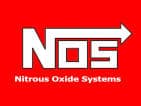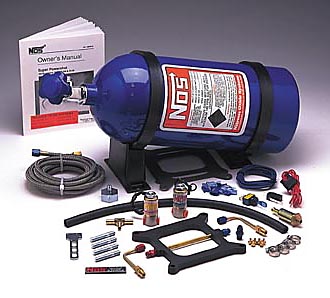Subjects:
- Operation
- History NOS systems
- Effect of NOS
- Dry and Wet systems
Operation:
NOS (N2O) is an abbreviation of Nitrous Oxide Systems. For the engine, Nitrous Oxide, sometimes also called nitrous oxide, is a more pure form of normal air. Since we are only interested in the oxygen in the air, Nitrous Oxide is an easy way to increase the amount of oxygen to get more horsepower. The extra power always comes from extra fuel. Nitrous Oxide is not a fuel. Nitrous Oxide is an easier way to get more oxygen needed to burn more fuel. When Nitrous Oxide is supplied to the engine, combustion is accelerated. The Nitrous Oxide only ensures that larger amounts of fuel can be burned in the same amount of time. The overall effect is a significant increase in engine power.

History NOS systems:
You wouldn't say it, but the use of Nitrous Oxide in engines dates back to World War II. The Allies used it in their planes to have extra power on hand in times of emergency so that the plane could go faster and climb to greater heights. Interest disappeared with the advent of jet engines. In the XNUMXs, the interest for this returned, but now in racing. It has not disappeared since then. In the beginning, they were quite provisional systems where things often went wrong. But by companies such as Nitrous Oxide Systems (NOS), Nitrous X-press, the product has been further developed so that safety has improved considerably compared to the past.
During the XNUMXs, famed stock-car racer 'Smokey Yunick' rediscovered nitrous oxide injection as one of his many tricks for winning races, until it was discovered and banned by NASCAR. Nevertheless, several scandals have come to light within NASCAR over the years of the misuse of nitrous oxide and it is probably still used by the slowest of racers to this day. In the late XNUMXs and early XNUMXs, nitrous oxide was discovered by street racers.
Dry and Wet systems
There are 2 different types of Nitrous systems: the Dry and Wet systems (dry and wet).
- Dry-System: The “dry” system is the subject of most confusion. A “dry” Nitrous system simply means that the required fuel is supplied by the standard injectors. The upper part of the intake manifold remains dry (no fuel). This is achieved through two methods. First, the pressure is increased by the administration of Nitrous when the system is activated. This causes an increase in fuel flow. The second way to deliver the required fuel is to increase the time the injectors are open. This is done by changing what the computer “sees”; force the computer to add the required fuel. Now that there is enough fuel, the extra fuel can be burned with the Nitrous and thus provide more power.
- Wet-System: The second type of Nitrous kit is a “wet” system. The kit dispenses Nitrous and fuel at the same time. This system wets the upper part of the intake manifold with fuel. This system is recommended for turbo/supercharged engines.

